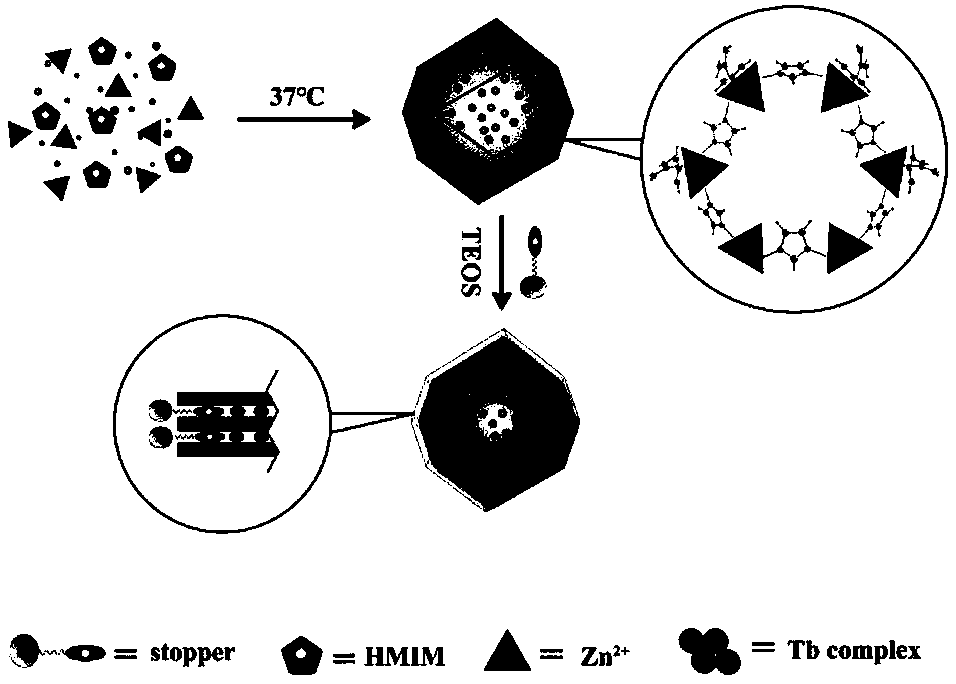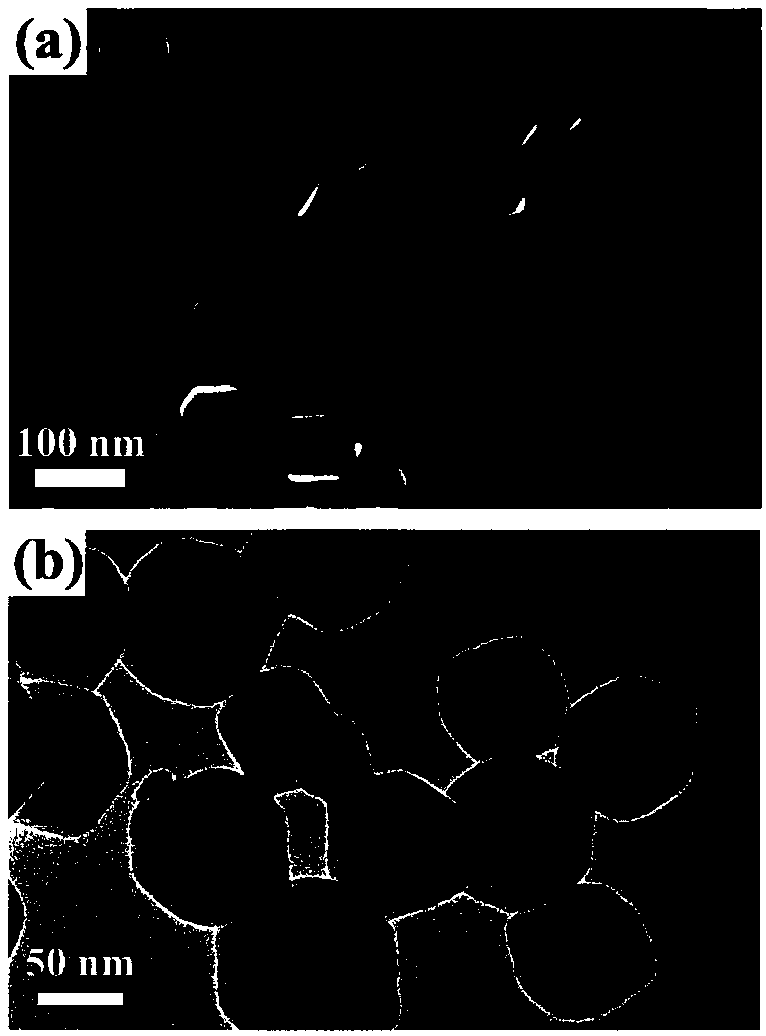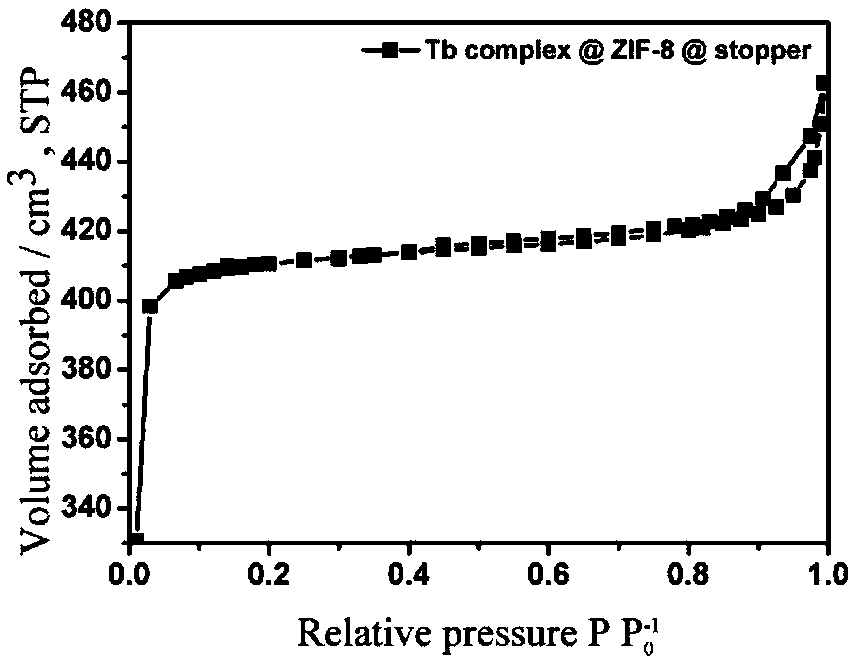Fluorescent nanoparticles and preparation method thereof
A fluorescent nanoparticle and nanoparticle technology, applied in the field of fluorescent nanoparticle and its preparation, can solve the problems of difficult application of fluorescent labeling, intolerance, poor fluorescence stability, etc., and achieve good monodispersity, uniform scale, fluorescence strong signal effect
- Summary
- Abstract
- Description
- Claims
- Application Information
AI Technical Summary
Problems solved by technology
Method used
Image
Examples
Embodiment 1
[0040] Such as figure 1 As shown, the simulation schematic diagram of the preparation method of fluorescent nanoparticles loaded with ZIF-8 rare earth complexes provided by the embodiment of the present invention, the preparation method of fluorescent nanoparticles loaded with ZIF-8 rare earth complexes provided by the present invention includes the following steps:
[0041] Step 1, pyridine two tetrazole (H 2 pytz) and triethylamine were dissolved in 1~2mL of methanol, added to a 10mL single-necked flask, mixed evenly, and then 1~4mL of terbium trifluoromethanesulfonate [Tb(OSO 2 CF 3 ) 3 ] Methanol solution in the system, stirred at room temperature for 24 hours, then vacuum-dried to remove the solvent to obtain a rare earth complex. The mass ratio of pyridine ditetrazolium, triethylamine and terbium trifluoromethanesulfonate is (43.3-129.2): (30.4-60.75): (30.3-121.2).
[0042] Step 2: Weigh 0.5 mg of the rare earth terbium complex and dissolve it in 200-300 μL of deion...
experiment example 2
[0054] The unblocked stopper nanoparticles obtained in step 2 and the fluorescent nanoparticles loaded with ZIF-8 rare earth terbium complex obtained in step 4 were respectively dispersed in PBS buffer solution with pH = 7.4, and the particle concentration was configured to be 1 mg mL -1 solution, select the excitation light wavelength as 304nm, and detect the fluorescence emission intensity of the particles at 543nm every 20 minutes to verify the stability of the fluorescence. Such as Figure 8 It can be seen from the figure that when no stopper and TEOS are added, the fluorescence intensity of the particles continues to decay over time; when the stopper and TEOS are added at a ratio of 1:2, the stability of the fluorescent nanoparticles is enhanced, and the number of It does not attenuate for hours, indicating that the particles have good tolerance to the high salt concentration and complex ion environment in the physiological system.
Embodiment 2
[0056] Step 1, pyridine two tetrazole (H 2 pytz) and triethylamine were dissolved in 1~2mL of methanol, added to a 10mL single-necked flask, mixed evenly, and then 1~4mL of terbium trifluoromethanesulfonate [Tb(OSO 2 CF 3 ) 3 ] Methanol solution in the system, stirred at room temperature for 24 hours, then vacuum-dried to remove the solvent to obtain a rare earth complex. The mass ratio of pyridine ditetrazolium, triethylamine and terbium trifluoromethanesulfonate is (43.3-129.2): (30.4-60.75): (30.3-121.2). After stirring at room temperature for 24 hours, the rare earth complex was obtained.
[0057] Step 2: Weigh 0.1 mg of the rare earth terbium complex and dissolve it in 200-300 μL of deionized water, and add it into a 10 mL single-necked flask. After uniform dispersion, add 2-methylimidazole (HMIM) with a mass of 45-54 mg and 14-16.8 mg of hexahydrate and zinc nitrate (Zn(NO 3 ) 2 ·6H 2 O). Finally, add 400-600 μL of methanol into the system and mix well, and react...
PUM
 Login to View More
Login to View More Abstract
Description
Claims
Application Information
 Login to View More
Login to View More - R&D
- Intellectual Property
- Life Sciences
- Materials
- Tech Scout
- Unparalleled Data Quality
- Higher Quality Content
- 60% Fewer Hallucinations
Browse by: Latest US Patents, China's latest patents, Technical Efficacy Thesaurus, Application Domain, Technology Topic, Popular Technical Reports.
© 2025 PatSnap. All rights reserved.Legal|Privacy policy|Modern Slavery Act Transparency Statement|Sitemap|About US| Contact US: help@patsnap.com



